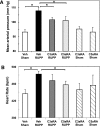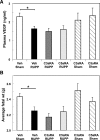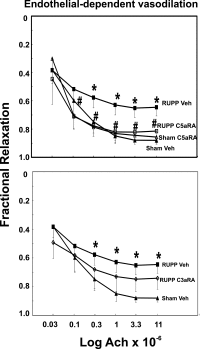Differential effects of complement activation products c3a and c5a on cardiovascular function in hypertensive pregnant rats
- PMID: 25150279
- PMCID: PMC4201271
- DOI: 10.1124/jpet.114.218123
Differential effects of complement activation products c3a and c5a on cardiovascular function in hypertensive pregnant rats
Abstract
Early-onset pre-eclampsia is characterized by decreased placental perfusion, new-onset hypertension, angiogenic imbalance, and endothelial dysfunction associated with excessive activation of the innate immune complement system. Although our previous studies demonstrated that inhibition of complement activation attenuates placental ischemia-induced hypertension using the rat reduced uterine perfusion pressure (RUPP) model, the important product(s) of complement activation has yet to be identified. We hypothesized that antagonism of receptors for complement activation products C3a and C5a would improve vascular function and attenuate RUPP hypertension. On gestational day (GD) 14, rats underwent sham surgery or vascular clip placement on ovarian arteries and abdominal aorta (RUPP). Rats were treated once daily with the C5a receptor antagonist (C5aRA), PMX51 (acetyl-F-[Orn-P-(D-Cha)-WR]), the C3a receptor antagonist (C3aRA), SB290157 (N(2)-[(2,2-diphenylethoxy)acetyl]-l-arginine), or vehicle from GD 14-18. Both the C3aRA and C5aRA attenuated placental ischemia-induced hypertension without affecting the decreased fetal weight or decreased concentration of free circulating vascular endothelial growth factor (VEGF) also present in this model. The C5aRA, but not the C3aRA, attenuated placental ischemia-induced increase in heart rate and impaired endothelial-dependent relaxation. The C3aRA abrogated the acute pressor response to C3a peptide injection, but it also unexpectedly attenuated the placental ischemia-induced increase in C3a, suggesting nonreceptor-mediated effects. Overall, these results indicate that both C3a and C5a are important products of complement activation that mediate the hypertension regardless of the reduction in free plasma VEGF. The mechanism by which C3a contributes to placental ischemia-induced hypertension appears to be distinct from that of C5a, and management of pregnancy-induced hypertension is likely to require a broad anti-inflammatory approach.
Copyright © 2014 by The American Society for Pharmacology and Experimental Therapeutics.
Figures







References
-
- American College of Obstetricians and Gynecologists. Task Force on Hypertension in Pregnancy (2013) Hypertension in pregnancy. Report of the American College of Obstetricians and Gynecologists’ Task Force on Hypertension in Pregnancy. Obstet Gynecol 122:1122–1131 - PubMed
-
- Ames RS, Lee D, Foley JJ, Jurewicz AJ, Tornetta MA, Bautsch W, Settmacher B, Klos A, Erhard KF, Cousins RD, et al. (2001) Identification of a selective nonpeptide antagonist of the anaphylatoxin C3a receptor that demonstrates antiinflammatory activity in animal models. J Immunol 166:6341–6348 - PubMed
-
- Björk J, Hugli TE, Smedegård G. (1985) Microvascular effects of anaphylatoxins C3a and C5a. J Immunol 134:1115–1119 - PubMed
Publication types
MeSH terms
Substances
Grants and funding
LinkOut - more resources
Full Text Sources
Other Literature Sources
Medical
Molecular Biology Databases

